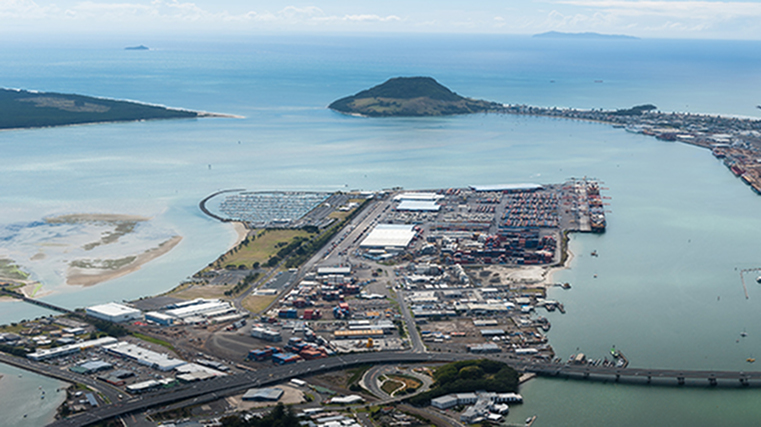Port of Tauranga continues to grow
Port of Tauranga continues to grow as an international hub port, resulting in increased trade volumes and profits for the first of the 2018 financial year.
Posted on 22 February, 2018

Results
Revenue for the six months to 31 December 2017 increased 12.8 per cent to $141.4 million and net profit rose 12.6 per cent to $47.1 million, following strong growth in most cargoes.
Half year trade volumes grew 13.4 per cent to 12.5 million tonnes, contributing to a 12.8 per cent increase in revenue to $141.4 million for the six months ending December 2017.
Transhipment volumes, where containers are transferred from one service to another, was up 47.6 per cent on the same period last year when measured by TEUs (twenty foot equivalent units).
Port of Tauranga Chair, David Pilkington, said the impressive results demonstrated the continued consolidation of a “hub and spoke” port network in New Zealand.
“Tauranga serves as a hub for New Zealand shippers looking to quickly and efficiently move cargo to and from North Asia, and South America via big ship services,” said Mr Pilkington.
“Tauranga is the only New Zealand port able to accommodate the larger container ships on these international services.”
Port of Tauranga Chief Executive, Mark Cairns, said the transhipment figures showed just how much New Zealand shippers had come to utilise Tauranga as an international cargo hub.
Growth had accelerated following the September 2016 completion of a major dredging project that was the culmination of a $350 million expansion programme.
“We are delighted by the amount of transhipment occurring from other New Zealand ports, with transhipment volumes having more than trebled for the six-month period - the largest increases occurring from the South Island ports and Napier,” said Mr Cairns.
Cargo Trends
Cars and other imported vehicles are a growing category for Port of Tauranga, with volumes increasing significantly as compared with the first half of the 2017 financial year.
The total number of containers handled increased 15.8 per cent to 590,803 TEUs and ship visits increased to 890 - 15.0 per cent more than the previous corresponding period.
Bulk cargoes are also increasing in volume. Mr Cairns said export growth had been driven by logs, which were in high demand by China and attracting record prices.
Imported cargoes grew significantly, with strong growth in oil products, and grain and feed supplements for the dairy industry.
MetroPort Auckland handled 8.4 per cent more TEUs over the six months, compared with the previous corresponding period. The number of trains between MetroPort and the Tauranga Container Terminal has been increased from 78 to 86 per week to handle the growing volumes.
“We have the capacity to increase train frequency in future as we still have plenty of headroom on the route between Auckland, Hamilton and Tauranga. KiwiRail’s work to build passing loops in recent years has future-proofed our rail capacity,” said Mr Cairns.
Mr Cairns said the Company was now looking to the next phase of growth and scoping the people, plant and processes required to maximise productivity within the Port’s existing footprint. Of its 190 hectares of land, the Port has approximately 40 hectares of land still available for cargo growth.
“We can handle up to three million TEUs annually without any further reclamation, which has been been confirmed in the recent Ernst Young Port Future Study1 ” said Mr Cairns.
“We consider all evidence points to the trend to larger vessels continuing and even accelerating. Port of Tauranga is the only port in New Zealand able to accommodate the big ships and their cargoes.”
The Company has consistently delivered on a strategy of sustainable long term value creation for shareholders. We recognise that long term value creation necessitates ongoing efforts to enhance our environmental performance as stewards of our natural environment and also recognition of our societal responsibility in how we manage the relationships that we have with our employees, our suppliers and the impacts of our business on the broader community in which we operate.
Associate companies
PrimePort Timaru had a strong first half on the back of bulk cargo growth, seeing a 36.1% increase in net profit.
Northport’s trade volumes continue to grow. Recently acquired contracts in new cargoes are starting to bear fruit for Quality Marshalling, with earnings up 28.3% on the previous corresponding period.
Coda Group’s profit declined compared with the previous corresponding period largely due to lower income from reduced empty container handling.
Outlook
Port of Tauranga is on track to handle in excess of 1.2 million TEUs in the year ending 30 June 2018.
Due to the strong trading conditions, Port of Tauranga is raising its earnings guidance to between $92 million and $96 million for the 12 months to June 2018. This compares with the Net Profit After Tax of $83.4 million for the year ended 30 June 2017.

